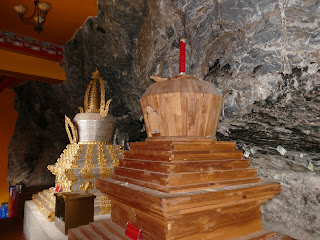 |
| The two chortens inside the cave, photo by Katia Buffetrille, 2018 |
A guidebook to a Padampa Cave — a cave in Yunnan we’ve blogged about before — has shown up in print, in a publication that may be a little difficult to find. The original guidebook is carved in stone. We would assume it was on the wall of the cave, although people who have been there (B.B., T.D., and K.B.) assure me no such inscription is in evidence. So maybe it was carved on a moveable slab of rock. I’ll let you know.
I had noticed photos of this stone inscription more than once in published books, but in a size so small it was impossible to read more than one syllable here and another there with the help of a strong magnifying glass. I tried scanning it and blowing it up on the computer screen, but at 400% magnification it just turned into a pixelated blur. If it is possible to read at all it is only because it was transcribed in an article by Saerje listed below.
It was not all that easy to recognize the name of the author of the stone guidebook, but I think I could succeed in that. At least the historical section that it contains was by someone called in the colophon Dbang-chen Bzhad-pa-rdo-rje-bskal-bzang, and I’m now convinced this has to be the Fourth Incarnation of ’Jam-dbyangs-bzhad-pa (1856-1916), so important to the history of Labrang, one of the biggest and most important monasteries in Amdo still today. You can see a sketch of his life in Paul Nietupski’s book, and an entry about him by Sonam Dorje may be found at Treasury of Lives website. I couldn’t right away locate his guidebook in the five volumes of his collected works (TBRC no. W22203), but that doesn’t mean it isn’t there. Small things like this might be buried inside a work with a completely different title.
 |
| Phadampa with his Cutting School iconography; The image has the look of one just taken off the rack in Chengdu. Photo by Katia Buffetrille, 2018 |
Well, the stone inscription is much too long, and often poetic in a difficult kind of way, so I am not going to translate it for you right now. If you are ready to read the Tibetan you can read it in both Tibetan letters and Wylie transcription in Saerji’s essay linked below. We’ll say goodbye for now.
§ § §
All photos in this blog were taken on site by Katia Buffetrille in 2018, and used here with permission. The earlier Tibeto-logic blog, Padampa Site Sighted in Yunnan, is here.
Paul K. Nietupski, Labrang Monastery: A Tibetan Buddhist Community on the Inner Asian Borderlands, 1709-1958, Lexington Books (Lanham 2011). The biography of the Jamyang Zhepa IV is on pp. 140-145.
Saerji (Gsar-brje), “Buddhapāla → Dam pa sangs rgyas ← Bodhidharma” [in Chinese], contained in: Wang Bangwei, Chen Jinhua and Chen Ming, eds., Studies on Buddhist Myths: Texts, Pictures, Traditions and History, Proceedings of the International Symposium on Cross-cultural Researches on Buddhist Mythology, Zhongxi Book Company (Shanghai 2013), pp. 165–176.
_____, “The Studies on the Narrative Inscriptions of Master Dharma Cave in Yunnan Province” [in Chinese with some Tibetan], contained in Wang Song, ed., Engaged Buddhism: The History and Reality of Asia, Proceedings of the 2015 Chong Sheng International Forum, Religious Culture Publishing House (Beijing 2016), pp. 97–127. See if this link takes you to it.
To tell you a secret that anyway shouldn’t be one, I made out a few syllables in a published photograph* and dropped those syllables in the Schmooglebox — that’s the only reason I could come up with Saerje’s Chinese article, since the internet bots had already indexed the Wylie Tibetan transcription of the inscription... So we have to thank the combination of author, stone carver, photographer, transcriber, publisher, scanner, OCRer and indexer, not to forget the search engine’s maker! And they say interdependent origination isn’t a thing? Well, right, it's not, it’s a whole spectrum of things, each of them not amounting to all that much in itself.
(*In case you are curious, this published photograph may be seen in a physical book I keep in my home library: Dkon-mchog-bstan-’dzin, et al., Bod-kyi Lag-shes Kun-'dus Chen-mo, Krung-go'i Bod Rig-pa Dpe-skrun-khang (Beijing 2010), in 2 vols. at vol. 1, p. 68, a small figure in the lower left-hand quarter of the page, bearing the inscription: Yun-nan Lis-su Yul-gyi Pha Rgya-gar Dam-pa'i Sgrub-pa Phug-tu Bod-yig-gi Rdo-brkos Gnas-bshad [Guide to the Holy Place Carved in Stone in Tibetan Letters in the Practice Cave of Father India Holyman in Lisu Country of Yunnan]. The two-volume set as a whole covers a wide range of Tibetan cultural arts with plenty of illustratons, and the Padampa inscription appears there as just another example of Tibetan stonecarving skills.)
-----
As I have no idea who its maker is, even if he is the only person in it, the inclusion of this video should not be regarded as any sort of endorsement. I’m just saying that the scenery you see at the beginning is germane to the content of this blog. You might want to overlook the channelling and phallicism. Make of it what you will, just leave me out of it please.
https://www.youtube.com/watch?v=tWC6C2M3BIs&ab














No comments:
Post a Comment
Please write what you think. But please think about what you write. What's not accepted here? No ads, no links to ads, no back-links to commercial pages, no libel against 3rd parties. These comments won't go up, so no need to even try. What's accepted? Everything else, even 1st- & 2nd-person libel, if you think they have it coming.